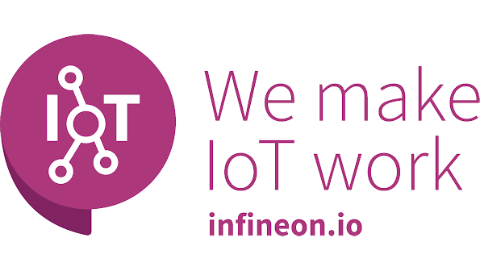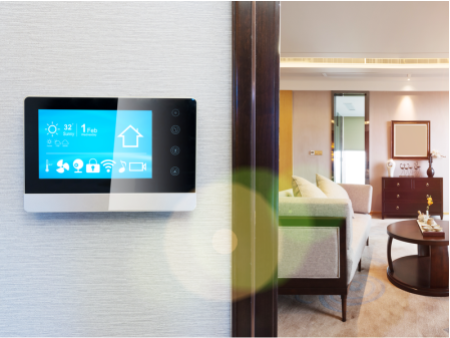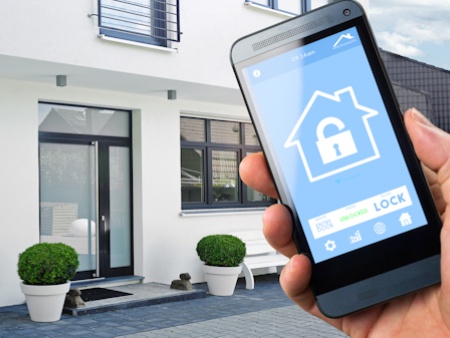
Comfortable, safe, and energy-efficient
The IoT makes buildings safer and more comfortable
The technological features of smart homes and smart buildings bring improved comfort, energy efficiency, and security. Semiconductor solutions enable smart home appliances and systems in building services to adapt to their situation and surroundings in operation. Sensors, actuators, and control systems all work together to enable components in a smart home or smart building to correctly collect, evaluate, and process real-time data before executing or initiating the appropriate action or reaction. In this context, security solutions safeguard the system and all of its activities against external cyber-attacks.
There were already around 16 million active IoT connections in smart buildings in Europe in 2019. In 2025, this figure is set to increase to around 154 million connections."
Infineon’s semiconductor solutions make residential and commercial buildings smart to increase comfort and convenience.

What makes homes and buildings smart?
According to projections by the United Nations, more than seven out of ten people will live in cities by the year 2050. This will push the development of megacities with high-rise buildings, large apartment blocks, and massive office/public buildings. Digitalization will play a defining role in all of these buildings. According to the European Telecommunications Network Operators’ Association, there will be around 154 million active IoT connections in smart buildings by 2025. And that’s just Europe!
Adding intelligence to homes and cities of the future
Infineon’s semiconductor solutions enable smart home appliances and systems in building services to adapt to their situation and surroundings in operation. Sensors, actuators, and control systems all work together to enable components in a smart home or smart building to correctly collect, evaluate, and process real-time data before executing or initiating the appropriate action or reaction. In this context, security solutions safeguard the system and all of its activities against external cyber-attacks.
Quieter, energy-efficient appliances driven by intuitive sensor-based operation
Sensors are a smart building’s nervous system
Equipping buildings with sensors puts them in a position to collect data on operation and the environment in order to react to this gathered information in real time. Infineon’s XENSIV™ family offers a wide range of solutions for such situations:
XENSIV™ MEMS microphones can be used to implement voice control, for example. Capacitive sensors from the CapSenseTM family are an elegant and reliable solution for controlling devices via touch.
Meanwhile, motions can be effectively detected by radar sensors. With their small form factor and low power consumption, Infineon’s highly integrated XENSIV™ 60 GHz radar sensor solutions bring innovative, intuitive sensing capabilities to many applications.
REAL3™ image sensors with ToF technology supply accurate depth data in real time, react quickly, feature contactless operation, and are robust against ambient light.
Infineon XENSIV™ sensor technology
Infineon XENSIV™ MEMS microphones
"See", "hear" and "feel" its environment
Smart air conditioner
Air conditioning systems are joining the ever-expanding list of “things” that are connecting to the Internet of Things. An air conditioning system equipped with semiconductors and connected to the Internet of Things (IoT) can understand its surroundings and can react to the needs of the people present.
Semiconductors support the green and digital transformation and are the heart of smart aircons

Standard/basic functionality such as stable and smooth start-up plus variable operating speeds and vibration suppression are considered essential must-haves. In addition, cooling systems in private homes must be quiet.
However, the increasing demand for energy-saving devices also requires that intelligent air conditioning systems only run when they are really needed, and only at the necessary intensity. In the EU, 50 percent of the energy consumed in buildings and industry is used for heating and cooling. So smart aircons must be able to analyze their environment and control their performance accordingly. This is made possible by sensors and controllers which identify the location and number of people in a room on an anonymous basis. Using this information, the smart air conditioning system then regulates performance on a need-driven basis, modifying fan speed as well as swing scope.
Other advantages of a smart air conditioner are that they can measure the temperature, CO2 concentration and air quality. They automatically and autonomously decide when it is necessary to provide fresh, cool air.
But they can do much more: thanks to machine learning, they adapt to the user's preferences, they provide data to the manufacturer about their condition and thus prevent expensive damage from occurring. All this is possible thanks to innovative semiconductor solutions.
How we enable commercial HVAC applications
We provide customers with the right technologies and innovations to address current and future security, functionality, connectivity, and performance demands for smart HVAC systems.
FOr example our XENSIV™ family provides manufacturers with best-in-class MEMS sensors to increase design intelligence by enabling smart aircon systems to “see”, “hear”, “feel” and “understand” their environment. CIPOS™ IPMs integrate the latest power semiconductors and control IC technology to create highly integrated, compact power modules capable of driving motors across a wide range of applications. And our PSoC™ 6 microcontrollers provide a secure solution for IoT developments, supporting multiple, simultaneous environments without the need for external memories or system on chips (SoCs). Our experienced technical experts and partners support customers with the tools and know-how they need to easily design and implement future-proof smart aircon systems.
Actuate
Power semiconductors guarantee high efficiency in energy conversion
Actuators use the data and information received to control and actuate the connected devices in the relevant building. Infineon’s OptiMOS™ N-channel power MOSFETs are designed for high-performance applications, boasting high efficiency, high power density, and optimization for high switching frequencies. Highly integrated ICs for motor control applications like the iMOTION™ series and intelligent power modules (IPMs) from the CIPOS™ family have been developed to keep motors running efficiently in household appliances, fans, and pumps, among other things.
Power management applications for mains power supplies to home appliances, set-top boxes, or even telecommunications systems/servers with a maximum rated output power of 43 W can be realized with robust CoolSET™ AC-DC power stages. Infineon’s portfolio is neatly rounded off by a wide variety of discrete IGBTs.
Infineon power semiconductor solutions
Infineon OptiMOS™ N-Channel power MOSFET
Connect
Networking for efficient data exchange
Connectivity is a crucial feature of smart homes and smart buildings: It is what transforms building elements into smart connected devices that can send and receive data. With this in mind, Infineon offers solutions to suit all kinds of communication systems:
WICED Wi-Fi + Bluetooth combos integrate IEEE 802.11a/b/g/n/ac WLAN and Bluetooth into a single-chip solution to enable small-form-factor IoT designs. Many of the Wi-Fi + Bluetooth combos are supported by WICED Wi-Fi and ModusToolboxTM software development kits that provide code examples, tools and development support.
Infineon’s Bluetooth portfolio consists of purely Bluetooth Low Energy-only and dual-mode Bluetooth solutions that support Bluetooth Classic (i.e., Basic Rate (BR) and Enhanced Data Rate (EDR)), as well as Bluetooth LE. The Bluetooth SDK contains everything you need to build dual-mode applications (BR + EDR + Bluetooth LE). The Bluetooth SDK, along with the ModusToolboxTM IDE, and Bluetooth configurator tools all combine to form a powerful but easy to use toolset that will help you create amazing, Bluetooth-enabled IoT solutions.
Secure
Scalable, easy-to-integrate security solutions
A hardware-embedded IoT security architecture is crucial for arming smart homes and smart buildings against cyberattacks. Infineon is addressing this challenge with its wide range of tried-and-tested, and certified hardware-based solutions, aiming a strong protection of data and devices in smart homes and smart buildings:
The OPTIGA™ family offers a broad product portfolio for embedded security solutions and secured cellular connectivity designed for easy integration. These hardware-based security solutions scale from basic authentication chips to sophisticated cloud implementations. With our OPTIGA™ Authenticate family we give “things” an identity to verify authenticity. This is the prerequisite to create trust in the digital world, especially within the IoT. The OPTIGA™ Connect product family enables our customers to connect their products via secured cellular connectivity. Enabling trusted data to empower integrity and enabling trustworth communication to foster confidentiality are the clear goals of our OPTIGA™ Trust and OPTIGA™ TPM families.
Finally, SECORA™ Blockchain is a fast, easy-to-use Java Card™ solution supporting best-in-class security for blockchain system implementation. It makes the application more secure and easier to designing for the customer’s block chain system easier.
Application examples
Home Appliances
Radar-based entrance counter
Accurate, anonymous, contactless
COVID-19 has rapidly increased the need for social distancing solutions in public buildings. The smart entrance counter is one such solution. It counts when a person enters or leaves a building or a room, and simultaneously ensures social distancing. The system uses a 60-GHz radar sensor and integrated software; people are counted accurately and anonymously. A traffic-light system tells people whether access is permitted or not.
The expected demand for this type of solution amounts to 90 million units globally. The system is easy to install and is simply mounted to the wall or ceiling of an entrance/exit area. It can be used in any type of building, including public buildings, retail stores and grocery stores, restaurants, schools, and corporate spaces, such as canteens, offices, etc.
Make connected buildings smart with Infineon’s full-spectrum sensor portfolio
Contextual awareness – the senses of the IoT
Sensors make homes and buildings smart by enabling them to “see”, “feel” and “hear” their environment – just like our human five senses do.
A smart building or home becomes smart through its connected and intelligent devices that are placed inside of it, for example heating, ventilation and air conditioning, elevators, access control, lighting, energy supply, or water heating systems. These elements itself are not smart. However, when equipped with the right technology, they are able to “see”, “hear” and “understand” their surroundings and perform appropriate actions. Sensors are the neural system of a building that collect in real-time data about a building’s operation, environment and its devices.
How radar can make your home intuitively smart
Reflecting our holistic approach to IoT design, our vision is to complement our XENSIV™ sensors with state-of-the-art software to create a comprehensive picture of the world around us. Our broad sensor portfolio spans MEMS microphones, plus pressure, radar, environmental, and 3D image sensors (REAL3™). All of which enable designers to create more intelligent, contextually aware devices.
High-precision sleep-monitoring based on radar
Sensors are the starting point of the Internet of Things. The more precisely they capture data, the more reliable the applications based on them will be. The number of possible use cases is large.
Watch the video to learn how smart health devices can be integrated into the smart home using intelligent sensors and a new form of sleep monitoring.
Radar-based entrance counter: Accurate, anonymous, contactless
COVID-19 has rapidly increased the need for social distancing solutions in public buildings. The smart entrance counter is one such solution. It counts when a person enters or leaves a building or a room, and simultaneously ensures social distancing. The system uses a 60-GHz radar sensor and integrated software; people are counted accurately and anonymously. A traffic-light system tells people whether access is permitted or not. The expected demand for this type of solution amounts to 90 million units globally. The system is easy to install and is simply mounted to the wall or ceiling of an entrance/exit area. It can be used in any type of building, including public buildings, retail stores and grocery stores, restaurants, schools, and corporate spaces, such as canteens, offices, etc.
Watch the video for more information
For more information about our entrance counter solution, click here.
A breath of fresh air: XENSIV™ PAS CO2 sensor to detect carbon dioxide (1/2)
Although everyone has an intuitive sense of when a meeting gets "stuffy", unfortunately we humans don't have anything like sensors for ambient air quality. But Infineon does!
Indoor spaces with increased CO2 concentration levels not only have poor air quality which can for example cause headaches, here we also find raised levels of aerosol concentration – one of the most common transmission paths for COVID-19. Regular ventilation is a good preventive step, but who wants to spend lots of time sitting in a draft of cold air? Wouldn't it be great if we could only air out meeting rooms whenever it's really necessary!
Click on the next slide to watch the video to learn more about the PAS principle and how our XENSIV™ PAS CO2 sensor works.
Explore use cases and start evaluating!

Visit our new Makes Sense page and let Chipman show you the latest use cases and application examples!
Measure what matters
Predictive maintenance and condition monitoring
Highly reliable solutions unleashing the benefits of condition-based monitoring vs predictive maintenance with our XENSIV™ sensor portfolio
Time and again, malfunctions in HVAC and refrigeration systems interrupt operations and increase maintenance costs. Predictive maintenance, which is a data-based maintenance strategy for predicting system malfunctions before they happen, can be an effective way to avoid unplanned downtime. To illustrate the benefits of a sensor-based solution, Infineon has collaborated with Klika Tech and AWS to develop a sensor-based evaluation kit. It enables designers to easily evalauate the benefits of condition monitoring and predictive maintenance. Using a range of sensors, paired with microcontrollers, embedded security, and software, the kit allows operators to monitor various parameters of vital components such as compressors, motors, and fans in real time, so that any potential anomalies can be detected immediately. If an anomaly is detected, the responsible maintenance technicians can be informed in good time – before the system fail – to address the problem, e.g. by replacing a worn part or cleaning an air filter.
Our broad range of XENSIV™ sensors can be deployed to monitor everything from single components of production machinery to an entire smart building ecosystem. Typical use cases include HVAC equipment where XENSIV sensors monitor current, vibration, and airflow in motors, compressors, and fans. These sensors can be combined with FreeRTOS-certified XMC™ microcontrollers and OPTIGA™ Trust security solutions so the data collected can be securely processed and analyzed, thus paving the way for advanced IoT features such as predictive maintenance. Leveraging our differentiated portfolio of memory solutions including SEMPERTM NOR Flash and EXCELONTM F-RAM to reliably and safely store collected data for such analysis, our end-to-end offering enables overall system health and safety to be monitored.
Connected Home over IP standard
Simple installation of devices from different suppliers
Across the globe, leading manufacturers and suppliers of smart home devices are collaborating to develop a global standard for the smart home. The working group "Connected Home over IP" from Zigbee Alliance wants to increase the compatibility and the security of smart home products and simplify their use. This is because aspects such as secure and easy installation and control of smart home solutions are becoming important criteria for consumers when making their purchasing decision.
With the Connected Home over IP standard, the identity of a device can be saved and updated within a hardware-based security system throughout its entire life cycle – from the design phase through to scrapping. This means users can dispense with weak passwords, protect device integrity through secure firmware updates, and encrypt private data according to the state of the art. The Connected Home over IP standard is meant to help manufacturers significantly increase the level of security of smart home devices, whilst also keeping costs and complexity as low as possible – thanks to the easy-to-integrate security hardware.
Seamless, secure interoperability with the Connected Home over IP standard

- The consumer buys a device with Connected Home over IP standard like a coffeemaker. The device is already preloaded with related software and a set of credentials to prove its unique identity and certification status.
- To add the device to the home, the consumer has to scan a QR code with the phone and to press the pairing button in the device.
- The phone will verify the device’s initial credentials and set it up on the network. Ready! Now it can be controlled with the phone, the smart speaker or other installed devices.
Power over Ethernet
IoT installed in a flash
Power over Ethernet (PoE) means that sensors and other IoT devices in building technology can be installed much more quickly, as the LAN cable doesn't just transfer the data, but simultaneously supplies the devices with power, as well. Although PoE has been around for a number of years, the latest standard IEEE 802.3bt has provided for an increase in the maximum power available, this can be achieved by using a twisted-pair Ethernet cable. This means that is now possible to supply power of up to 100 W per connection. A PoE switch can supply several devices with power at once by simply connecting the devices to the switch using conventional Ethernet cables. This simplifies both the installation process and any subsequent reconfigurations of the building technology systems.
The advantages of PoE are being leveraged by "The Edge", an innovative office building in Amsterdam, which was fitted with 650 PoE switches. These enable users to control the lights and temperature, for example, by means of a smartphone app. Thus, the facility manager has a clear overview of all of the building functions and can maximize the efficiency of the building operations. Over a 20-month period, it was possible to reduce the costs per employee by more than 1,800 euros.



